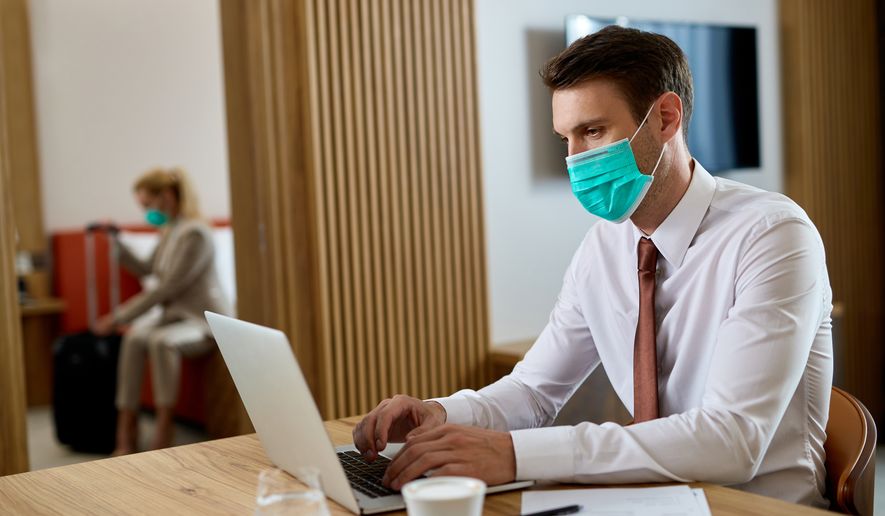Hotels increasingly have rented rooms as workspaces to telecommuters to recoup lost revenue and reservations during the COVID-19 pandemic.
Yannis Moati, CEO of the Hotels by Day booking service, said Wednesday that a surge in workspace requests has boosted his sales by 50% over pre-pandemic levels, even as the larger hospitality industry continues to cope with record losses.
“Before the pandemic, we were very much a leisure service,” said Mr. Moati, whose agency helps people rent daytime rooms from every major hotel chain. “Now we’re having a lot more work-related services simply because people moved from urban to suburban locations during the pandemic and need an office.”
STR, the hotel industry’s leading market researcher, reported Friday that 62.9% of the nation’s 9.3 million guest rooms in 70,000 hotels were occupied last month — a slight increase over September’s 61.8% occupancy rate, but still 8.8% lower than the pre-pandemic occupancy rate in October 2019.
The STR report said the average daily hotel rate in October was $134.78 — a 1.2% increase over the pre-pandemic rate — and revenue per available room dropped 7.6% to $84.75 over the same period.
“Hoteliers will continue to face many challenges in the recovery — COVID case trends, labor shortages, supply chain delays, and the slow return of group and business travel,” said Alison Hoyt, STR’s senior director of consulting.
Jan L. Jones, who teaches hospitality and tourism management in the Pompea College of Business at the University of New Haven in Connecticut, said the increased use of guest rooms as workspaces reflects the hotel industry’s effort “to come up with new strategies” in response to competition from cheaper vacation rentals and the reality that remote work may continue after the pandemic fades.
“I think we’re going to see moving forward a lot of different changes in the workweek and in where people work,” Ms. Jones said.
The trend had already started before the pandemic, she added, with Airbnb’s offer of cheaper stand-alone accommodations forcing hotels to rethink the way they do business.
“Airbnb became very popular early in the pandemic because it’s cheaper, and it allowed families to travel without being around strangers in a hotel,” Ms. Jones said.
Mr. Moati of Hotels by Day said the share of “intraday hotel spaces” it rented for business purposes rose from 9% before the pandemic to a peak of 35% in April. About 30% of the booking service’s sales now come consistently from workplace rentals.
Founded in 2015, Hotels by Day allows customers to reserve guest rooms in seven-hour daytime blocks at 50% of the nighttime rate from 2,000 hotels owned by Marriott, Wyndham, Hilton and other chains. The hotels usually allow people to rent the rooms from four to nine hours between 10 am and 8 pm.
Nevertheless, Hotels by Day’s sales declined 82% during the first few weeks of April 2020 as COVID-19 lockdowns spread throughout the U.S.
“It rebounded because we’ve had workers renting rooms for the day to escape the confines of home, rather than for the traditional pool and spa use,” Mr. Moati said.
The American Hotel and Lodging Association (AHLA) projected in August that the industry will finish 2021 down more than $59 billion in business travel revenue from 2019, after losing nearly $49 billion in business travel revenue in 2020.
The industry trade group reported that U.S. hotels made $89.5 billion in revenue in 2019 and will clear just $30.3 billion this year, a 66.2% drop from pre-pandemic levels.
That would mean a worse financial fallout this year than 2020, the industry’s worst year on record for occupancy and one the AHLA has said was nine times worse than 9/11 for travel.
The corporate offices of Wyndham and Marriott, the nation’s two largest hotel chains, declined to comment.
InterContinental Hotels Group, the nation’s fourth-largest hotel chain that also allows bookings through Hotels by Day, said most of its 4,037 locations have continued to prosper as midscale and upper-midscale brands that reach consumers seeking a room somewhere between budget and luxury prices.
Karen Cole, director of corporate communications for IHG’s Americas Region, said the third quarter saw occupancy rates of 70% in the chain’s Holiday Inn Express properties and 80% in its Extended Stay brands — both of which exceeded 2019.
“Overall, it’s our broad portfolio that helped us in this phased recovery,” Ms. Cole said in an email.
For more information, visit The Washington Times COVID-19 resource page.
• Sean Salai can be reached at ssalai@washingtontimes.com.




Please read our comment policy before commenting.